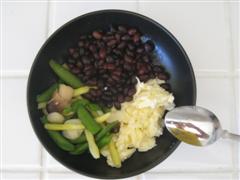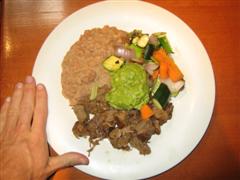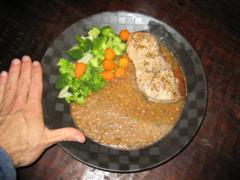Trans fat
raises your "bad" (LDL) cholesterol and lowers your "good"
(HDL) cholesterol. Find out more about trans fat and how to avoid it...
When it comes to fat, trans fat is considered by some doctors to
be the worst type of fat. Unlike other fats, trans fat — also called
trans-fatty acids — both raises your "bad" (LDL) cholesterol and
lowers your "good" (HDL) cholesterol.
A high LDL cholesterol level in combination with a low HDL
cholesterol level increases your risk of heart disease, the leading killer of
men and women. Here's some information about trans fat and how to avoid it.
What is
trans fat?
Trans fat is made by adding hydrogen to vegetable oil through a
process called hydrogenation, which makes the oil less likely to spoil. Using
trans fats in the manufacturing of foods helps foods stay fresh longer, have a
longer shelf life and have a less greasy feel.
Scientists aren't sure exactly why, but the addition of hydrogen
to oil increases your cholesterol more than do other types of fats. It's
thought that adding hydrogen to oil makes the oil more difficult to digest, and
your body recognizes trans fats as saturated fats.
Trans fat
in your food
Commercial baked goods — such as crackers, cookies and cakes —
and many fried foods, such as doughnuts and french fries — may contain trans
fats. Shortenings and some margarines can be high in trans fat.
Trans fat used to be more common, but in recent years food
manufacturers have used it less because of concerns over the health effects of
trans fat. Food manufacturers in the United States and many other countries
list the trans fat content on nutrition labels.
However, you should be aware of what nutritional labels really
mean when it comes to trans fat. For example, in the United States if a food
has less than 0.5 grams of trans fat per serving, the food label can read 0
grams trans fat. Though that's a small amount of trans fat, if you eat multiple
servings of foods with less than 0.5 grams of trans fat, you could exceed
recommended limits.
Reading
food labels
How do you know whether food contains trans fat? Look for the
words "partially hydrogenated" vegetable oil. That's another term for
trans fat.
It sounds counterintuitive, but "fully" or
"completely" hydrogenated oil doesn't contain trans fat. Unlike
partially hydrogenated oil, the process used to make fully or completely
hydrogenated oil doesn't result in trans-fatty acids. However, if the label
says just "hydrogenated" vegetable oil, it could mean the oil
contains some trans fat.
Although small amounts of trans fat occur naturally in some meat
and dairy products, it's the trans fats in processed foods that seem to be more
harmful.
Trans fat
and cholesterol
Doctors worry about trans fat because of its unhealthy effect on
your cholesterol levels — increasing your LDL and decreasing your HDL
cholesterol. There are two main types of cholesterol:
Low-density lipoprotein (LDL). LDL, or
"bad," cholesterol transports cholesterol throughout your body. LDL
cholesterol, when elevated, builds up in the walls of your arteries, making
them hard and narrow.
High-density lipoprotein (HDL). HDL,
or "good," cholesterol picks up excess cholesterol and takes it back
to your liver.
A high LDL cholesterol level is a major risk factor for heart
disease. If your LDL is too high, over time, it can cause atherosclerosis, a
dangerous accumulation of fatty deposits on the walls of your arteries. These
deposits — called plaques — can reduce blood flow through your arteries. If the
arteries that supply your heart with blood (coronary arteries) are affected,
you may have chest pain and other symptoms of coronary artery disease.
If plaques tear or rupture, a blood clot may form — blocking the
flow of blood or breaking free and plugging an artery downstream. If blood flow
to part of your heart stops, you'll have a heart attack. If blood flow to part
of your brain stops, a stroke occurs.
Other
effects of trans fat
Doctors are most concerned about the effect of trans fat on
cholesterol. However, trans fat has also been shown to have some other harmful
effects:
Increases triglycerides. Triglycerides are a type of
fat found in your blood. A high triglyceride level may contribute to hardening
of the arteries (atherosclerosis) or thickening of the artery walls — which
increases the risk of stroke, diabetes, heart attack and heart disease.
Increases Lp(a) lipoprotein. Lp(a) is a type of
LDL cholesterol found in varying levels in your blood, depending on your
genetic makeup. Trans fats make Lp(a) into smaller and denser lipid particles,
which promotes a buildup of plaques in your arteries.
Causes more inflammation. Trans fat may increase
inflammation, which is a process by which your body responds to injury. It's
thought that inflammation plays a key role in the formation of fatty blockages
in heart blood vessels. Trans fat appears to damage the cells lining blood
vessels, leading to inflammation.
Avoiding
trans fat
The good news is trans fat is showing up less in food,
especially food on grocery store shelves. If you eat out a lot, however, be
aware that some restaurants continue to use trans fat. Trans fat is sometimes a
part of the oil restaurants use to fry food. A large serving of french fries at
some restaurants can contain 5 grams or more of trans fat.
How much trans fat you can safely consume is debatable. However,
there's no question you should limit trans fat, according to the Food and Drug
Administration and the American Heart Association (AHA).
In the United States, food nutrition labels don't list a Daily
Value for trans fat because it's unknown what an appropriate level of trans fat
is, other than it should be low. The AHA recommends that no more than 1 percent
of your total daily calories be trans fat. If you consume 2,000 calories a day,
that works out to 2 grams of trans fat or less, or about 20 calories.
Don't think a food that is free of trans fat is automatically
good for you. Food manufacturers have begun substituting other ingredients for
trans fat. However, some of these ingredients, such as tropical oils — coconut,
palm kernel and palm oils — contain a lot of saturated fat. Saturated fat
raises your LDL cholesterol. A healthy diet includes some fat, but there's a
limit.
In a healthy diet, 25 to 35 percent of your total daily calories
can come from fat — but saturated fat should account for less than 10 percent
of your total daily calories. Aim for consuming less than 7 percent of your fat
calories from saturated fat if you have high levels of LDL cholesterol.
 Monounsaturated fat — found in olive, peanut and canola oils —
is a healthier option than is saturated fat. Nuts, fish and other foods
containing unsaturated omega-3 fatty acids are other good choices of foods with
monounsaturated fats.
Monounsaturated fat — found in olive, peanut and canola oils —
is a healthier option than is saturated fat. Nuts, fish and other foods
containing unsaturated omega-3 fatty acids are other good choices of foods with
monounsaturated fats.













